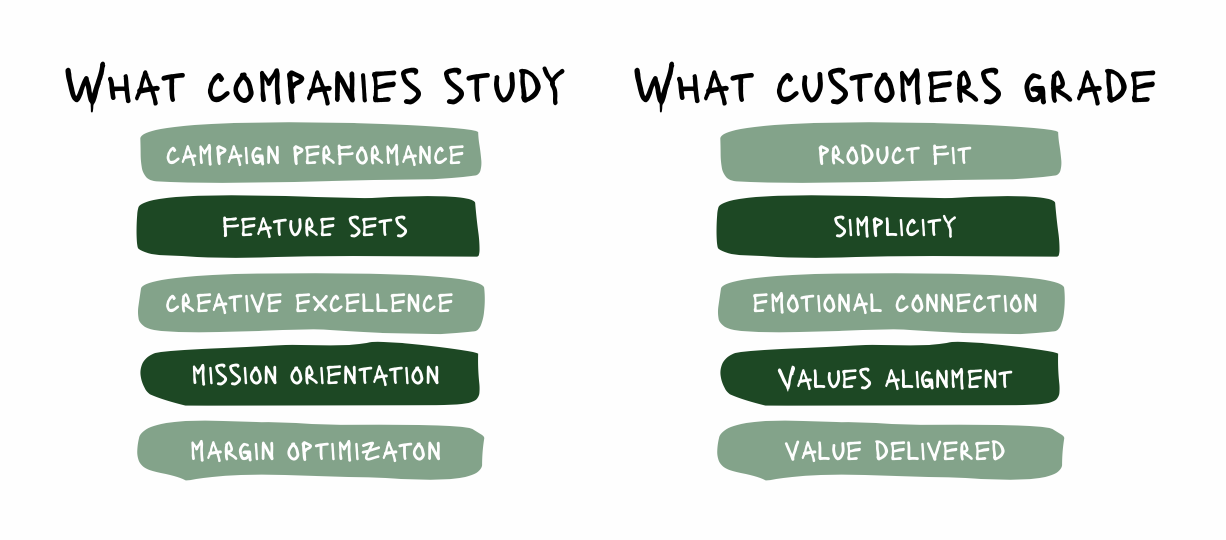To Brand or Not to Brand…
Ask any CEO or founder if they want a great brand, and they'll universally say yes (if not, they should be fired immediately). Yet the concept of "brand" remains plagued by misperceptions. Too often, its meaning or value is reduced to expensive Super Bowl ads or updating fonts and colors – which explains why CMOs feel like they're walking the plank whenever brand conversations arise.
I speak from experience and have the PTSD to prove it.
One founder/CEO told me, "We don't do 'brand' here," and literally banned the term from meetings. Another insisted that focusing on brand means you're not focusing on growth (hoo boy). And nearly every conversation with executive recruiters begins with the dreaded "Are you more brand or performance?" question.
I can hear the eye rolls from those who've endured these same conversations.
However, here's the uncomfortable truth: brand has a brand perception problem.
It's Not Us, It's You
This long-distance dedication goes out to my CMO friends – you know this song by heart. When a brand is struggling, it's often attributed to "marketing issues." Budgets get slashed, headcount gets frozen, and you’re suddenly persona (and function) non grata. And what is usually the first line item to go? Brand. That’s because it’s frivolous, a luxury. Brand is what you talk about during "peacetime." But wartime? Brand goes into the bunker.
Here's the irony: the business gets rocky because of a rocky brand.
Growth slowing? That's a brand problem. Engagement drops? That's a brand problem. Customers no longer see the value and churn increases? That's a brand problem.
It may seem like I'm beating up on the marketers who I just said get enough heat, but the reality is brand is everyone's problem.
When you have a high-functioning brand, it's because all parts of the customer experience are working harmoniously, and that requires all areas of an organization. But if one part of that experience weakens, then you risk the whole house of cards falling. So rather than unfairly asking marketing to hold all the cards, it's time we split the deck and treated brand as a full-funnel, company-wide priority.
The KPI FALLACY
But three letters consistently stand in the way of that reality: KPI.
Companies spend a lot of time and energy hustling to develop KPIs each quarter. From my experience, it's always a scramble. As a functional leader, I found myself frantically grading our previous quarter's KPIs (some already irrelevant or long abandoned) and even more frantically conjuring up a new set of goals to meet the internal deadline. An EA chases me one last time, and I finally deliver my scorecard of greens, yellows, and the dreaded reds, which gets copied and pasted into a master corporate deck alongside the other functional leaders. Mission accomplished!
But what did we actually accomplish?
I would argue not much. In fact, it reminded me of high school and that feeling of pure panic when you forgot to study for a test or left writing a paper until the last second. Further, each department was essentially grading its own homework, probably padding its grades a bit. For example, marketing celebrates a 40% email open rate, but in reality, those results sit in the bottom quartile for their industry. Product brags about shipping 12 new features, but customer onboarding is still problematic. Customer success reports 85% satisfaction, yet churn is on the rise. So it’s actually quite challenging to get a true sense of how well the brand’s health is in such a siloed system.
But here’s another big problem: our customers grade us using a different set of criteria. And I would argue that how they measure a brand is a lot more meaningful to your prospects than how you score yourself. The bottom line: your customers are your teachers, and they determine if you'll pass or fail.
WHAT IF…
What if we stopped reducing brand to ads and fonts and treated it like a full-funnel, all-hands-on-deck opportunity?
What if we put aside outdated KPIs and focused our attention on making the greatest brand possible?
Or to put it more academically: what if we stopped constantly cramming for the wrong test?
A ‘GREAT’ POINT AVERAGE
We've all experienced the highs and lows of maintaining a grade point average (GPA) in school. The majority of opportunities you get after school (college admissions and job interviews) are based heavily, and in some cases solely, on your GPA.
Just like teachers grade students, customers are constantly grading brands, and they expect an ‘A’ experience every time they engage.
When an experience is a ‘C’ or a ‘D’ (or dare I say an ‘F’), it has a direct impact on growth. But just like bombing a test doesn't mean your overall GPA will plummet, a bad quarter doesn’t mean you’re headed for expulsion. However, when there are consistent issues that affect loads of customers that don’t get properly addressed, you can kiss the dean's list goodbye.
In school, it was easy to understand where you stood thanks to your GPA. So what’s the business equivalent? The Brand GPA, or “great” point average.
The Brand GPA is a framework that takes into account what businesses often look at and what customers most often care about, and frames it in an academic context across five subjects: Chemistry, Communications, Psychology, Sociology, and Economics.
Chemistry measures your customer-brand fit through usage, affinity, and retention. Communications evaluates how clearly and consistently you tell your brand story across channels. Psychology captures how your brand makes people feel. Sociology assesses how your brand engages with the world. Finally, Economics looks at perceived and actual value, from initial purchase to lifetime value.
And just as academic subjects are weighted differently, so are the subjects of the Brand GPA. That way, you’re able to focus the right amount of attention and resources when a particular subject’s grade starts to slip. In the Brand GPA framework, Chemistry is the heaviest hitter, coming in at a 30% weighting. Communications and Economics are next at 20% each, followed by Psychology and Sociology at 15%.
It's Not If You're Being Graded, But How
The Brand GPA isn't just about measuring differently. It's about measuring what actually matters to the long-term success and overall “greatness” of your brand. It provides an outside-in view that cuts through departmental myopia and gives you an accurate grade so you know how much to allocate and how much to worry.
Customers evaluate your Chemistry aptitude based on how much they like and rely on your brand. They're scoring your Communications based on how consistent you are every interaction and touchpoint. They're scoring your Psychology based on how you make them feel. They're grading your Sociology based on your values and actions. They're calculating your Economics through the value you deliver relative to what you charge. And fair warning: they’re tough graders.
So will your brand make the grade in the eyes of your customers – or will your customers send you straight to brand detention?
✔️ Deep dives into each core subject with sub-subjects anchored in real and relevant business metrics. Learn exactly what drives Chemistry (Activity, Affinity, Retention), Communications (Clarity, Engagement, Responsiveness), Psychology (Motivation, Personalization, Control), Sociology (Alignment, Advocacy, Cultural Resonance), and Economics (Value Perception, Revenue Expansion, Economic Efficiency)—all with industry-specific benchmarks.
✔️ Case studies of brands "Making the Grade" or "Missing the Mark" across multiple business verticals. From Netflix's Chemistry mastery to Spirit Airlines' Communications catastrophe, you’ll get data-backed stories of brands that have scored high with their customers across each subject, and others that are on the brink of failure.
✔️ Pop Quizzes for immediate diagnostic application so you can calculate your own brand's GPA right now with weighted scoring that accounts for industry context.
What's Inside THE BRAND GPA
✔️ The Valedictorians gives an in-depth analysis from the top "scholars" across industries. See how brands like Duolingo, Canva, and Trader Joe’s consistently earn straight As by consistently mastering all five subjects.
✔️ The Comeback Kids proves that all is not lost if your brand falters. Discover how brands like Abercrombie & Fitch, Twilio, and Yahoo turned their GPAs around by going back to fundamentals and listening to their customers.
✔️ A Shared Language for CEOs and CMOs (finally!) The Brand GPA is a brand health diagnostic, strategic planning framework, and resource allocation guide rolled into one, designed to help both CMOs and CEOs finally speak the same language about brand. For CMOs and marketing leaders: Use this framework to have more productive conversations with your CEO and fellow executives about the importance of brand. Stop defending budget. Start showing scores. For CEOs and founders: Get a clear, measurable view of brand performance that aligns with business outcomes. See exactly where to invest and where you're at risk across every department, not just marketing.





